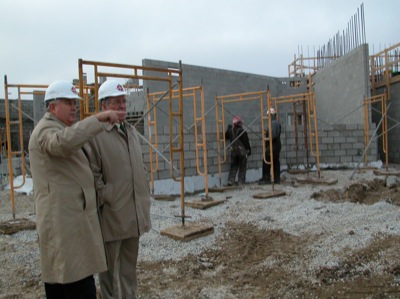Friday, December 12th, 2008
Celina water improves and cost savings found
By William Kincaid
The cost of carbon, which is the main ingredient in the city's new water treatment process, has doubled due to what Celina Safety Service Director Jeff Hazel calls the China-effect.
The significant inflation has led city officials to use regeneration, a process that allows the city to reuse the carbon and save money.
The new Granular Activated Carbon (GAC) facility contains eight tanks, each containing 40,000 pounds of carbon that absorbs the organic content in the city water drawn from Grand Lake. Test results show the process is working, and Celina water now meets EPA standards.
Every six months carbon must be replaced in one tank. Therefore, the city must buy around 320,000 pounds of carbon each year for all eight tanks.
Initially, the cost for carbon was between $1 and $1.10 per pound. However, in the last few months, that price increased to $1.62, city officials learned.
"It has to do with China carbon. China and Japan have just been buying and buying and buying," water plant Superintendent Mike Sudman said.
And there are only two domestic suppliers of U.S. carbon - Calgon Carbon, a company based out of Pittsburgh that supplies Celina at its Columbus facility, and Norit Americas in Oklahoma. Cheaper, foreign carbon was quickly ruled out because the product is inferior to U.S carbon and plant engineers advised against it, Sudman said.
To offset the high prices, city officials have begun regeneration or reusing its old carbon, Sudman said.
The Columbus company comes to Celina with three trucks - two to remove Celina's used carbon and another with a fresh load. The used carbon is blasted through a furnace at high temperatures to eradicate the organic material contained within it. Once processed, the regenerated carbon is stored at the Columbus facility and transported back to Celina when it's needed.
Sudman said there are no drawbacks to regenerated carbon.
When the city received its first load of carbon a few months ago, the price for new carbon was $96,000 for 40,000 pounds. Once the city changed to regenerated carbon, that price was reduced to $50,000. This week, the plant received its third load of carbon since going online this summer.
"We plan on using that carbon over and over through regeneration," Sudman said.
During a city committee meeting this week, councilman Bill Sell asked if Celina could share the associated costs and carbon with other state municipalities, such as Bowling Green, which has a GAC facility.
Hazel replied that cities can not mix carbon because of the specific conditions of their different water sources.
Water test results:
Recent test results of Celina's drinking water show significant improvement due to the new water treatment facility.
The maximum level of THMs, which lab tests have linked to some forms of cancer, in drinking water is 0.08 milligrams per liter, according to Ohio EPA standards. An EPA report released in November shows Celina's water is now at 0.027 milligrams per liter - well below state standards.
The new $6.3 million Granular Activated Carbon (GAC) water treatment facility at the site of the former Blue Goose was fully operational on July 21. The first test results in August showed a THM level of 0.043 milligrams per liter.
Prior to the GAC plant opening, a reading in May showed a THM level of 0.233 milligrams per liter.
The GAC plant's eight tanks each contain 40,000 pounds of carbon that absorbs the organic content in the city water drawn from Grand Lake. The goal is to reduce the organic material, which reacts with chlorine to form THMs.
Since Jan. 1, a debt assessment fee to pay for the new GAC plant has been added to all water bills. The fee ranges from $6.66 a month for residents inside the city, up to $93.18 a month for those with larger water lines outside the city. The assessment goes into an account to pay off the 20-year loan taken out to build the facility.
- William Kincaid


